By Ana Rodriguez Soto - The Archdiocese of Miami
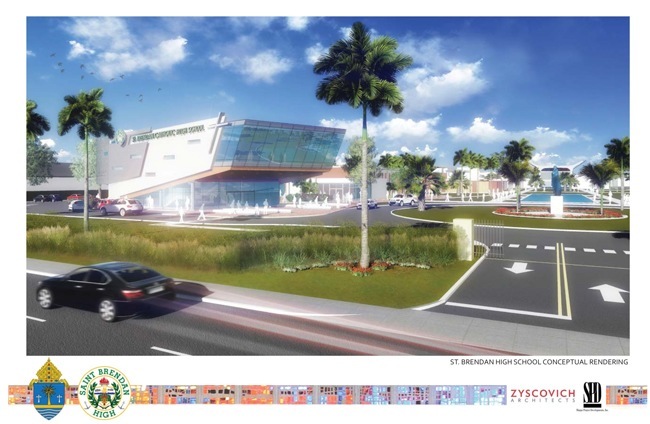
Photographer: COURTESY PHOTO
Architect's rendering of the new building that will go up on the grounds of St. Brendan High School in time for its 40th anniversary next year.
For starters, the school will begin construction on a new building � its first ever, since the three buildings and cafeteria now on site were originally built for the seminary next door, St. John Vianney.
Set for completion by December 2015, the new building will house offices, state-of-the-art labs and special classrooms for St. Brendan's four academies. These are self-contained "schools within a school" that put students on a path to specific careers in business and law, medicine, visual and performing arts, and the so-called STEM fields, science, technology, engineering and math.
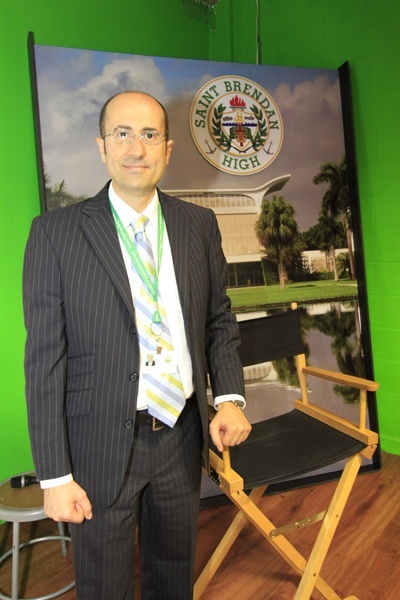
Photographer: ANA RODRIGUEZ-SOTO | FC
Jose Rodelgo-Bueno poses in front of the green screen of St. Brendan High School's TV studio and media lab.
"Its a big deal for our school, in which we never built anything," said Jos� Rodelgo-Bueno, St. Brendan's principal since 2012. "Basically, we have one big field and we do everything there."
The revamped fields will include separate spaces for soccer/lacrosse, baseball and softball, and track. Best of all, they will be available for use by teams from St. Brendan's feeder schools in southern Miami-Dade County, including "little St. Brendan" next door.
"It makes sense that we support each other," said Rodelgo-Bueno, whose enthusiasm and flair for innovation are spurring a renaissance at the archdiocesan high school.
With an enrollment of nearly 1,150, "St. Brendan is the largest archdiocesan high school in Miami-Dade County," he said.
In terms of fame, however, it lags behind its next door neighbor, the Marist-run Christopher Columbus High School. It's not that the schools are rivals, since St. Brendan is co-ed and Columbus is all-boys. Marist Brothers also taught at St. Brendan, and one served as principal until two years ago.
But the school tends to get overlooked even physically, wedged as it is between Columbus and St. John Vianney Seminary. Founded in 1975, St. Brendan until did not even own its buildings: They had been borrowed from the seminary when it closed its high school. Ownership was only transferred this year.
A native of Spain, Rodelgo-Bueno worked in the archdiocesan Office of Schools before joining St. Brendan's faculty as a geometry, Spanish and Italian teacher in 2010. Prior to that, he taught economics at the college level for four years.
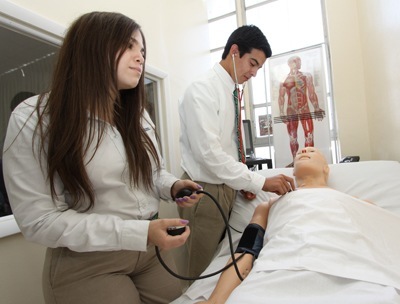
Photographer: ANA RODRIGUEZ-SOTO | FC
St. Brendan students Andres Rivera, right, who graduated this year, and Ashley Silvarrey, an incoming junior, measure the blood pressure of Hal the medical mannequin.
It's a prescription that takes into account growing competition from charter schools, which are privately-run, publicly-funded and free; and the religion-averse environment that young people confront in college and beyond.
"Were not going to disappear if we have a vision. Money and students follow vision," Rodelgo-Bueno said.
The academies function like majors in college, with students, classes and even clubs grouped under each academy's area of study. Students begin focusing on a particular area after freshman year, and even though they don't have to enroll in an academy, most do.
The goal is to help young people discern a career before they get to college, when changing majors gets expensive; to give them experience and internships along the way that will get them admitted to more prestigious colleges and universities; and to increase their chance of getting scholarships that make those schools affordable.
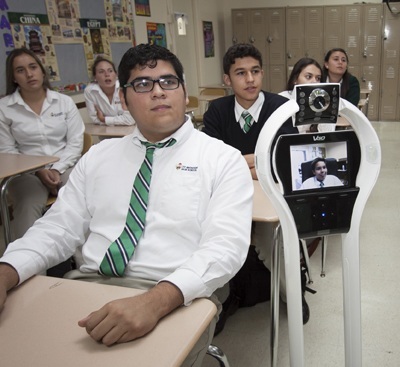
Photographer: ANA RODRIGUEZ-SOTO | FC
In a demonstration, incoming junior Kristopher Gonzalez (visible on the TV screen) participates in a St. Brendan High class via the school's rolling robot. It allows students to "go" to class while they are sick at home or in the hospital.
The academy model also results in a Catholic education that challenges students to mature.
"They can start having this conversation with God: What do you want me to do? What is Gods will for me? They have to find their path in life. But you have to challenge them," Rodelgo-Bueno said.
Since the academy model was implemented two years ago, enrollment has increased. "Suddenly, we are the number one choice for many families. And we are very proud," he added.
St. Brendan also is investing in technology: Not just iPads for each student and Apple TVs in each classroom but high-definition 60-inch TVs streaming a student-produced newscast and bulletin announcements throughout the school; a medical model named HAL that can be programmed to mimic myriad ailments; and a rolling robot that allows students who are ill to attend classes from home or the hospital.
All of that costs money, Rodelgo-Bueno admitted, "but our children deserve it."
Eight years ago, St. Brendan also pioneered an exchange student program that has brought as many as 80 young people from Italy and Spain to study at the high school, for as few as three months or as long as one year.
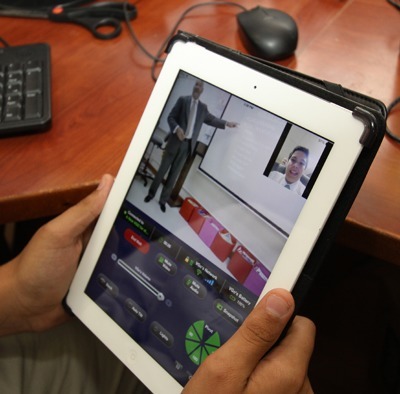
Photographer: ANA RODRIGUEZ-SOTO | FC
In a demonstration, incoming junior Kristopher Gonzalez (visible on the TV screen) participates in a St. Brendan High class via the school's rolling robot, which he is manipulating in another room. The robot allows students to "go" to class while they are sick at home or in the hospital.
Some St. Brendan students will be traveling to Europe soon to spend a few months at a partner school. The high school also began offering classes in Mandarin Chinese this year.
Rodelgo-Bueno does not take full credit for all of these initiatives, however.
"This is Catholic education coming from my founder," he said, referring to the late Father Luigi Giussani, founder of the Catholic movement Communion and Liberation. Rodelgo-Bueno is a member of the worldwide CL Fraternity.
Father Giussani wrote that "only a faith arising from life experience and confirmed by it (and, therefore, relevant to life's needs) could be sufficiently strong to survive in a world where everything pointed in the opposite direction."
In other words, Catholic education has to teach young people the importance of Jesus in real life, when they go to college, when they hang out with their friends, and when they are on the job.
"Putting doors on the ocean is impossible," Rodelgo-Bueno said. "What we have to do is, inside that ocean, propose something that is so attractive that everyone wants to come here."
His goal is to see that St. Brendan's students are "super prepared for college and careers, and at the same time, they dont lose their faith in college."


Comments from readers